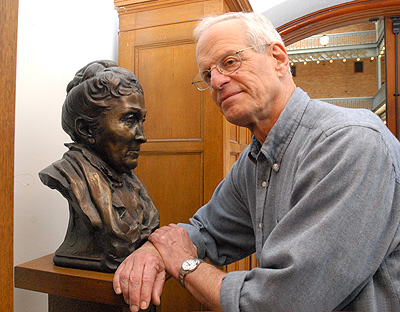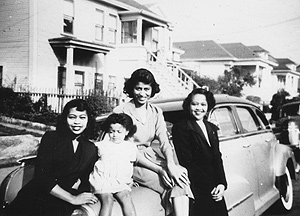Berkeleyan
 |
In the Hearst Memorial Mining Building, Charles Wollenberg contemplates a bust of Phoebe Apperson Hearst, whom he credits with taking the University of California from the minor to the major leagues in the early 1900s. (Peg Skorpinski photo) |
A chronicle of Berkeley: Nut Hill, chained suffragettes, and all
The town and the campus are joined at the historical hip, says Berkeley City College prof Charles Wollenberg
![]()
| 09 April 2008
Picture this: Berkeley’s mighty football team is on a tear. Ecstatic fans agitate for a new stadium. The site selected is the mouth of Strawberry Canyon — with its creek and native oaks, one of the most bucolic and unspoiled spots on campus.
From the masses, a collective howl rises: “No!”
“People showed up at meetings, and signed petitions,” says Charles Wollenberg, a professor of history at Berkeley City College and author of Berkeley: A City in History, new from UC Press. “People didn’t dress up in costumes and sit in trees. But there certainly was a popular protest.”
Though that story sounds contemporary, the year was 1921. Then, as now, Memorial Stadium sat at the heart of a controversy that put the university at odds with the community that surrounds it.
 South Berkeley residents on Harmon Street in 1950, when lingering housing discrimination restricted most African Americans and Asians to the south and west parts of town. (Source: Berkeley Public Library via the Online Archive of California) |
Call it town-and-gown relations, or university/community conflict, that almost tectonic friction, with all its subsurface rumbling and occasional disruptions, is as much a part of Berkeley’s historic underpinnings as the Hayward Fault, according to Wollenberg’s engaging and detail-packed account.
It can be traced back to 1873, the year the young College of California completed its metamorphosis into the University of California and moved five miles north from Oakland to what is now Berkeley.
“Literally the day it arrived, there began to be interaction between the university and the civilians who were already here,” Wollenberg recounted in an interview. “And that interaction was both positive and negative.”
The friction is its own kind of sibling rivalry, because Berkeley, the university, and Berkeley, the city, grew up together, Wollenberg shows.
It’s a topic woven through his book, which he researched in the Bancroft and Doe libraries as well as the Berkeley Public Library and the Berkeley Historical Society.
But he covers much more ground, showing how far back Berkeley established its unique character among American cities, and how much a part of that the university was, and is.
Along the way, Wollenberg conjures ghosts that haunt Berkeley to this day, written on street signs and buildings — names like Durant and Hearst, Domingo and Peralta, Kittredge, Shattuck, Hilgard, and Hillegass, all people who influenced Berkeley’s development.
“One of the things I wanted to do with this book is give people a sense of why the city is the way it is,” Wollenberg says. He places the city and the university in the context of regional, state, national, and world issues.
“And I put the present-day Berkeley into historical context,” he adds.
For example, Berkeley’s vaunted reputation as a left-leaning activist city mainly stems from the extraordinary 1960s, Wollenberg says. But the foundation for that was laid decades earlier.
Berkeley elected the state’s first socialist mayor, J. Stitt Wilson, in 1911, one of many examples of the city’s radical history that the book provides. That same year, California was just the sixth state to approve women’s suffrage — 15 years after Berkeley activist Theresa Jacquemine chained herself to a desk in the Alameda County recorder’s office until she was allowed to register to vote.
When it came to the deep cultural upheavals of the ’60s, “it isn’t surprising that it was Berkeley where these things came to the surface,” he says.
Weirdness in the hills
Likewise, Berkeley’s ’60s and ’70s counterculture didn’t come out of nowhere.
Ever hear of Nut Hill? That was the name given to a community of bohemians — including the influential architect Bernard Maybeck and his family — who experimented with new living styles and living spaces in the north Berkeley hills as early as 1894.
“The name may have referred either to the vegetarian diet of some of the residents or to the fact that some hill-dwellers had lifestyles their fellow citizens considered downright weird,” Wollenberg writes in a section titled “Berkeley Bohemia.”
Maybeck and his wife, Annie, for example, called their son “Boy” until he was old enough to select his own name, believing that “giving him a name would stunt his individuality.” (He picked “Wollenberg” after the author’s great-grandfather, who lived near the Maybecks and entertained neighborhood kids with his stories; Bernard and Annie shortened it to “Wallen.”)
“When people think about the counterculture, well, it isn’t something that just happened in the 1960s,’’ Wollenberg says.
Berkeley’s more conservative side also goes way back, he shows — still a Republican town in 1932, it voted for Herbert Hoover over Franklin D. Roosevelt for president.
Through history, Wollenberg says, leftist activism and conservatism “both exist at the same time. It reflects the huge divisions that are within the city at any given time.”
Nothing runs deeper than the city’s relationship with the university.
“There’s no way you can separate the city’s history and the university’s history from each other,” he says.
It was an uneasy fit from day one, as Wollenberg tells the tale.
When the university arrived, a bustling blue-collar community called Ocean View already thrived in the wharfside flatlands down by the Bay.
University trustees set about building a residential community around its site, inland along the hills. In fact, the new school might be known today as the University of California at Peralta, had trustees followed their first inclination and named the community for the Mexican family that held the original land grant here. Instead, they took its name from the 18th- century British philosopher and bishop George Berkeley.
The community that grew up around the university was mainly middle-class, native-born, and Protestant. Ocean View was more working-class, foreign-born, and Catholic. The struggle between the two came to define Berkeley politics, even as the communities grew together physically and became one city.
Open the classrooms, close the bars
“One of the first things the university did was to dam up Strawberry Creek for a water supply, and that began to affect the level in the wells of the people downstream in Ocean View,” Wollenberg says. Then the state Legislature banned alcohol within two miles of the university, and “that meant all the workingmen’s bars down in Ocean View theoretically had to close.
“And that’s all within a few weeks or months of when the university arrived,” Wollenberg says.
At the same time, as soon as the university moved in, many Ocean View residents found jobs building, maintaining, and servicing the university, and its merchants and manufacturers started selling their goods to the school, Wollenberg points out.
“From the beginning, there’s almost like a love-hate relationship,” he says. “In some respects, the struggle goes on to the present day — just ask the people up in the oak trees.”
In modern times, development and growth issues define town-and-gown relations more than social and class issues, Wollenberg says, because Berkeley is fully built out as a city.
The city of Berkeley may complain loudly about the university’s exemption from property taxes and zoning laws, but Wollenberg points out that the city also reaps big social, cultural, and economic benefits from the university’s
presence.
If you include the lab, the university employs more people than the next 9 employers in Berkeley combined, he says: “The economic impact is huge.”
And Berkeley’s international prominence has nothing to do with the city, Wollenberg says.
“When you go most places in the world and you say the word ‘Berkeley,’ people assume you’re talking about the university, not the town,” he says.
The social and cultural atmosphere engendered by the university attracts educated, creative, politically active people — who end up being among the university’s most fervent critics, Wollenberg says.
If the university’s founders came back to Berkeley today, they would be most surprised by the university’s size, its worldwide role, and “the extent to which research as opposed to teaching is such a fundamental value,” Wollenberg speculates.
“I think they’d also be amazed that it is just one of 10 campuses,” he says. “They thought they were establishing the university.”
Current students and faculty might be most intrigued to learn that early on “the university wasn’t a very distinguished institution.”
And what aspect of Berkeley history would most surprise campus newcomers?
“My guess is, most of it,” Wollenberg says. “I honestly think very few people have any knowledge at all of Berkeley history — and that includes an awful lot of the people who live in Berkeley.”

